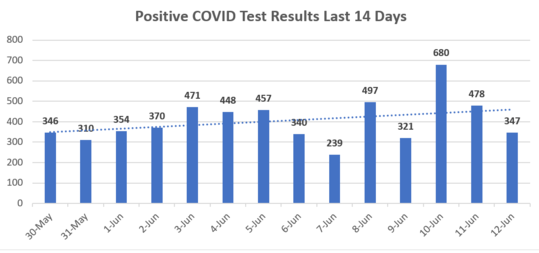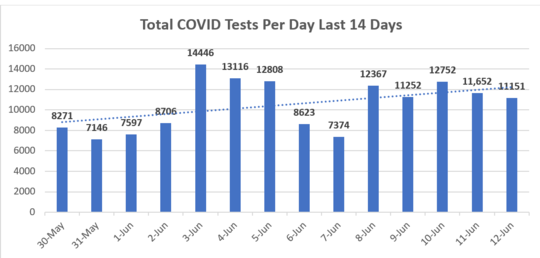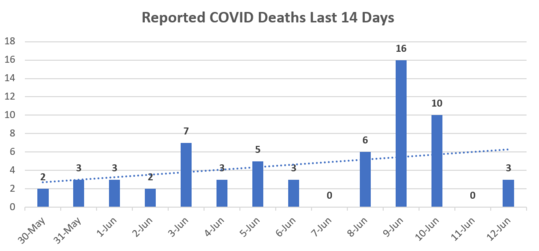|
June 12, 2021
Dear Neighbors and Friends,
Sorry that this newsletter is coming to you late. As I was about to publish it last night, I learned that the “GoDelivery” site was down for maintenance until 3 a.m. So you’ll get two of these today.
I hope that you and your loved ones are doing well, staying healthy, and looking out for your neighbors and friends in these difficult times.
This newsletter includes a report on the latest epidemiological COVID forecast for Oregon, which predicts accelerated declines in the coming weeks. Saturday’s reported metrics reflect that projected trend.
Please stay safe and let me know if you have any questions about information in today’s newsletter.
TODAY’S CORONAVIRUS AND CORONAVIRUS RESPONSE UPDATE
-
New COVID Cases: OHA reports 285 new COVID cases today. The cumulative number of cases in Oregon since the beginning of the pandemic is 204,865.
-
Variant COVID Cases: Here are the cumulative case counts for the COVID variants in Oregon: 1,240 (up from 1,152) cases of the B.1.1.7 (UK) variant, 200 cases (up from 176) of the P.1 (Brazilian) variant, and 108 (up from 86) cases of the B.1.351 (South African) variant. In addition, we are now seeing 279 (up from 257) cases of the B.1.427 variant, and 716 (up from 700) of the B.1.429 variant. OHA is now producing a Variant Dashboard, providing current variant case numbers for the state as a whole and for various parts of the state. It’s updated each Wednesday.
-
Positive Test Results: OHA reported 347 positive tests today. The cumulative total of positive test results since the beginning of the pandemic is now 297,206.
-
Total Tests: OHA reported an additional 11,151 tests today. Our cumulative total of reported tests is now 5,253,418.
-
Positivity Rate: The test positivity ratio for Oregon today is 3.1%.
-
Hospitalization Information: OHA only reports on the first two bulleted items over the weekend. I’ll update the other metrics on Monday.
- Patients Currently with Confirmed COVID-19: 160 (9 fewer than yesterday)
- ICU Patients Confirmed w COVID-19: 41 (1 more than yesterday).
- Available ICU Beds: 124 (13 fewer than yesterday)
- Other Available Beds: 485 (28 more than yesterday).
- Confirmed COVID-19 Patients Currently on Ventilators: 13 (3 fewer than yesterday)
- Available Ventilators: 789 (10 more than yesterday).
-
Deaths: I’m sorry to report 3 additional COVID deaths today. The total number of COVID deaths in Oregon is now 2,729.
-
Vaccinations:
- As of the end of yesterday, here are the latest numbers:
- New Immunizations Reported Today: 17,231
- 8,034 were conducted and reported yesterday
- 8,197 were conducted earlier, but the reports were received yesterday (there can potentially be a three-day window for reporting)
- The 7-day running average is now 17,567 doses per day.
- Total First and Second Doses Administered So Far: 4,188,850
- 2,364,446 Pfizer doses
- 1,667,165 doses
- 155,271 Johnson & Johnson doses
- Total Oregonians vaccinated so far: 2,315,940
- 2,019,299 now fully vaccinated with two doses
- OHA has not updated this metric, so the number of Oregonians who still need to get a first dose for Oregon to reach the 70% threshold remains 87,702 (5,532 fewer than the previous day)
- To date, 5,337,605 doses of vaccine have been delivered to sites across Oregon. (That’s the same as yesterday, so a total of just 47,960 doses came in last week.)
- 78.5% of these doses have been administered so far. The national average is now 82.3%.
- 56.4% of Oregonians have received at least one dose (64.0% of those 16 and older***, 67.4% of those 18+***, which is the CDC standard).
- 48.3% of Oregonians are now fully vaccinated (56.5% of those 16 and older***).
- ***OHA doesn’t update these figures over the weekend.
Additional Brief Updates
- Governor Brown announced today that, effective immediately, Clackamas County has been approved to move to the Lower Risk level under the state's public health framework to reduce transmission and protect Oregonians from COVID-19. The county today achieved a 65% first dose vaccination rate for adults and has submitted an equity plan to the state. You can read the press release here.
-
Here's more information about the plant in Baltimore that led to unusable Johnson and Johnson doses.
- I mentioned the other day a promising, unexpected source of COVID detection: specially trained COVID-detection dogs. Well, it turns out they still face a number of barriers.
- The Huffington Post has just published a long piece on Kip Kinkel, who was sentenced to 111+ years in prison as a result of his having killed his parents, as well as two of his schoolmates and wounding many others at Thurston High School in 1998 at the age of 15. This is the first time he has spoken with a member of the press at any length, and it’s a harrowing, difficult story of mental illness and the terrible impacts it can have on the self and others, The piece also includes discussion of Measure 11, the Oregon ballot initiative that created our current system of mandatory minimum sentences in the 1990s, particularly as it has impacted youth offenders, along with attempts in the Legislature to modify some of its more rigid and outdated elements. This is a difficult story, full of tragedy in many ways. As someone working on prison education and sentencing reform, I’ve gotten to know Kip a little from meetings I’ve had with him and other adults in custody at the Oregon State Correctional Institution in Salem (which are referenced in the article). I find the article’s portrayal of the man Kip is today to be quite accurate. I recommend it.
- Maxine Bernstein summarizes the Huffington Post piece on Kinkel and gives some of its key points in an Oregonian article that also appeared on Saturday.
Latest Epidemiological Forecast Released: COVID Reductions Should Continue
Today, OHA released its latest COVID-19 forecast, which showed lower transmission of the virus through late May and projects fewer hospitalizations and daily cases through June 29.
The forecast was produced by OHA with support from the Institute for Disease Modeling in Seattle. It reflects information collected up to June 1. To account for delays in reporting, diagnosed cases with a specimen collection date after June 1 were not used; they used the same cutoff date for hospital admissions and deaths. In the epidemiological model, cases tested on June 1 reflect exposures that occurred around May 26.
The Re (effective reproduction rate)--the expected number of secondary cases that a single case generates — was estimated at 0.66 through May 26 (another significant reduction from 0.86, and half the the Re in the forecast before that one).
An Re of 1.0 would have meant our numbers will stabilize at the current rate; an Re of 0.66 means we can expect significant reductions in the coming weeks.
The report finds that the 7-day rolling average of diagnosed cases had been increasing since mid-March but then began to decline in late April and through May. New hospitalizations increased between mid-March and early April but has been declining steadily since late April.
We’re still seeing a somewhat higher number of deaths compared to the earlier in the year as a result of the surge in April and early May. Deaths are lagging indicators, usually not occurring until a month or so after infection. With the lower case counts over the last month, we should see the number of deaths decline steadily.
The revised forecast again gives us two possible scenarios for the immediate future.
Scenario 1: Transmission Continues As-Is
If the transmission rate as estimated for May 26 (Re 0.66) continued, we would see a continued decline in diagnosed cases:
- For the two-week period between June 16 and June 29, the projected number of new diagnosed cases would decline to 34 per 100,000 people. This rate translates to a daily average of 100 cases.
- New hospitalizations would decrease to 5 per day by June 29.
Scenario 2: Transmission Increases by 20%
This scenario is intended to illustrate what might happen over the next month if the transmission rate were to increase due to more infectious variants and/or if protective behaviors were to decline among those not vaccinated as local restrictions are relaxed.
- New diagnosed cases would still decline, but more gradually, falling to 45 per 100,000 people for the two-week period between June 16 and June 29; this rate translates to a daily average of 135 cases.
- New hospitalizations would still decrease to 7 per day by June 29.
The reason for the reduced infection rate and the continued decline in cases and hospitalization is simply the overall successful rollout of the vaccines here in Oregon. Even though vaccination rates have slowed down, it remains harder for the virus to find people to infect. That’s not to say they it doesn’t have potential hosts that are ripe for infection among the unvaccinated—their infection rate is as bad as ever. But overall there are fewer of them.
This forecast is for the state as a whole. We may see higher or lower rates in different counties, particularly as vaccination rates vary.
The model also takes into account the fact that people who have been vaccinated have much higher resistance to infection than those who have already had COVID (estimated to be about 8.5% of Oregonians). A person who has had COVID-19 and recovered—i.e., someone with “natural immunity”—is likely more susceptible to reinfection than someone who has been vaccinated.
OHA does recommend that people who have already developed natural antibodies as a result of previous infection still get the vaccine to further increase their protection against COVID-19. People who have recovered from the disease and are subsequently vaccinated "have a particularly robust response to the vaccine" (i.e., they create more and longer-lasting antibodies to the disease).
Where Are Today’s Cases?
If we put together the positive test results and new “presumptive cases” reported today, the overall number of new cases reported is 285. Here is today’s breakdown by county:
Baker (2)
Benton (5)
Clackamas (28)
Columbia (3)
Coos (2)
Crook (9)
Curry (1)
Deschutes (14)
Douglas (30)
Gilliam (3)
Harney (2)
Jackson (15)
Jefferson (3)
Josephine (5)
Klamath (5)
Lane (22)
Lincoln (2)
Linn (9)
Malheur (3)
Marion (25)
Multnomah (37)
Polk (3)
Sherman (1)
Umatilla (10)
Union (1)
Washington (38)
Wheeler (1)
Yamhill (6)
And the Deaths
Oregon’s 2,727th death is a 77-year-old woman from Klamath county who tested positive on April 19 and died on May 5 at Providence St. Vincent Medical Center.
Oregon’s 2,728th death is a 93-year-old woman from Lane county who tested positive on April 7 and died on May 15 at her residence.
Oregon’s 2,729th death is a 96-year-old woman from Lane county who tested positive on June 8 and died on June 8 at her residence.





Want to See Past Newsletters?
If there was COVID-related information in a past newsletter that you want to go back to, but find you’ve deleted it, you can always go to my legislative website (senatordembrow.com), click on “News and Information,” and you’ll find them all there. Also, if someone forwarded you this newsletter and you’d like to get it directly, you can sign up for it there.
AND FINALLY,
Here again are some resources that you will find useful
If the above links are not providing you with answers to your questions or directing you to the help that you need, please consider me and my office to be a resource. We’ll do our best to assist you or steer you in the right direction.
Best,
 Senator Michael Dembrow
District 23
email: Sen.MichaelDembrow@oregonlegislature.gov
web: www.senatordembrow.com
phone: 503-281-0608
mail: 900 Court St NE, S-407, Salem, OR, 97301
|